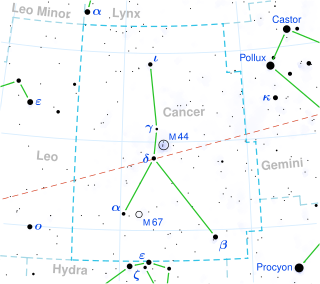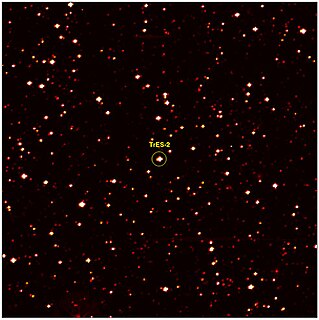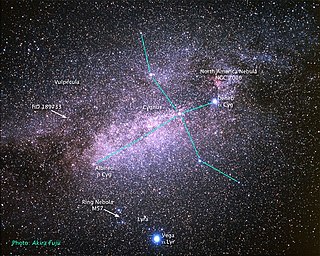 W
W55 Cancri is a binary star system located 41 light-years away from the Sun in the zodiac constellation of Cancer. It has the Bayer designation Rho1 Cancri (ρ1 Cancri); 55 Cancri is the Flamsteed designation. The system consists of a K-type star and a smaller red dwarf.
 W
WAlpha Centauri is the closest star system and closest planetary system to Earth's Solar System at 4.37 light-years from the Sun. The name is Latinized from α Centauri, and abbreviated Alpha Cen or α Cen. It is a triple star system, consisting of three stars: α Centauri A, α Centauri B, and α Centauri C.
 W
WDS Tucanae is a binary star system in the constellation of Tucana. It has an apparent visual magnitude of 8.5, and is a RS Canum Venaticorum variable. The system is notable for being young as a member of the 45 Myr old Tucana-Horologium moving group and for the primary star hosting the confirmed exoplanet DS Tucanae Ab, discovered by TESS.
 W
WGSC 03549-02811, also known as Kepler-1) is a yellow main-sequence star similar to our Sun. This star is located approximately 704 light-years away in the constellation of Draco. The apparent magnitude of this star is 11.41, which means it is not visible to the naked eye but can be seen with a medium-sized amateur telescope on a clear dark night. The age of this star is about 5 billion years.
 W
WHD 189733, also catalogued as V452 Vulpeculae, is a binary star system approximately 64.5 light-years away in the constellation of Vulpecula. The primary star is suspected to be an orange dwarf star, while the secondary star is a red dwarf star. Given that this system has the same visual magnitude as HD 209458, it promises much for the study of close transiting extrasolar planets. The star can be found with binoculars 0.3 degrees east of the Dumbbell Nebula (M27).
 W
WNN Serpentis is an eclipsing post-common envelope binary system approximately 1670 light-years away. The system comprises an eclipsing white dwarf and red dwarf. The two stars orbit each other every 0.13 days.
 W
WPSR B1620−26 is a binary star system located at a distance of 3,800 parsecs in the globular cluster of Messier 4 in the constellation of Scorpius. The system is composed of a pulsar and a white dwarf star or PSR B1620−26 B). As of 2000, the system is also confirmed to have an exoplanet orbiting the two stars.
 W
WTau Boötis, Latinized from τ Boötis, is an F-type main-sequence star approximately 51 light-years away in the constellation of Boötes. It is a binary star system, with the secondary star being a red dwarf. As of 1999, an extrasolar planet has been confirmed to be orbiting the primary star. In December 2020, astronomers may have detected, for the first time, radio emissions from a planet beyond our solar system. According to the researchers: "The signal is from the Tau Boötes system, which contains a binary star and an exoplanet. We make the case for an emission by the planet itself."
 W
WUpsilon Andromedae is a binary star located approximately 44 light-years from Earth in the constellation of Andromeda. The system consists of an F-type main-sequence star and a smaller red dwarf.
 W
W91 Aquarii is the Flamsteed designation for a triple star system in the equatorial constellation of Aquarius. It also bears the Bayer designation Psi1 Aquarii. It is visible to the naked eye with an apparent visual magnitude of +4.248. Parallax measurements yield an estimated distance of around 150 light-years from Earth. An extrasolar planet is known to orbit the main star.
 W
WFomalhaut, designation Alpha Piscis Austrini is the brightest star in the constellation of Piscis Austrinus, the "Southern Fish", and one of the brightest stars in the sky. It is a class A star on the main sequence approximately 25 light-years (7.7 pc) from the Sun as measured by the Hipparcos astrometry satellite. Since 1943, the spectrum of this star has served as one of the stable anchor points by which other stars are classified. It is classified as a Vega-like star that emits excess infrared radiation, indicating it is surrounded by a circumstellar disk. Fomalhaut, K-type main-sequence star TW Piscis Austrini, and M-type, red dwarf star LP 876-10 constitute a triple system, even though the companions are separated by approximately 8 degrees.
 W
WGliese 667 is a triple-star system in the constellation Scorpius lying at a distance of about 6.8 pc from Earth. All three of the stars have masses smaller than the Sun. There is a 12th magnitude star close to the other three, but it is not gravitationally bound to the system. To the naked eye, the system appears to be a single faint star of magnitude 5.89.
 W
WLTT 1445 is a triple M-dwarf system about 22 light-years distant in the constellation Eridanus. The primary LTT 1445 A hosts one exoplanet that transits the star every five days. As of August 2019 it is the second closest transiting exoplanet system discovered, with the closest being HD 219134 bc.
 W
WDawn is a science fiction novel by American writer Dean McLaughlin. A re-imagining of Isaac Asimov's 1941 short story "Nightfall", it was serialized in Analog magazine, with two cover illustrations, for both its first and last segments. The story was republished in hardcover in 2006.
 W
WKepler-16 is an eclipsing binary star system in the constellation of Cygnus that was targeted by the Kepler spacecraft. Both stars are smaller than the Sun; the primary, Kepler-16A, is a K-type main-sequence star and the secondary, Kepler-16B, is an M-type red dwarf. They are separated by 0.22 AU, and complete an orbit around a common center of mass every 41 days.